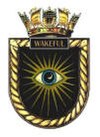HMS Wakeful (1943)

HMS Wakeful underway on 28 February 1944
|
|
| History | |
|---|---|
|
|
|
| Name: | HMS Wakeful |
| Ordered: | 3 December 1941 |
| Builder: | Fairfield Shipbuilding and Engineering Company, Govan, Scotland |
| Laid down: | 3 June 1942 |
| Launched: | 30 June 1943 |
| Commissioned: | 17 February 1944 |
| Identification: |
|
| Motto: |
|
| Fate: | Sold for scrap on 10 June 1971 |
| Badge: | |
| General characteristics as W class | |
| Class and type: | W-class destroyer |
| Displacement: | |
| Length: | 362.75 ft (110.57 m) o/a |
| Beam: | 35.75 ft (10.90 m) |
| Draught: | 10 ft (3.0 m) |
| Propulsion: |
|
| Speed: | 36 knots (67 km/h; 41 mph) / 32 knots (59 km/h; 37 mph) full |
| Range: | 4,675 nautical miles (8,658 km; 5,380 mi) at 20 knots (37 km/h; 23 mph) |
| Complement: | 179 (225 as leader) |
| Sensors and processing systems: |
|
| Armament: |
|
| General characteristics Type 15 frigate | |
| Class and type: | Type 15 frigate |
| Displacement: | 2,300 tons (standard) |
| Length: | 358 ft (109 m) o/a |
| Beam: | 37.75 ft (11.51 m) |
| Draught: | 14.5 ft (4.4 m) |
| Propulsion: |
|
| Speed: | 31 knots (57 km/h; 36 mph) (full load) |
| Complement: | 174 |
| Sensors and processing systems: |
|
| Armament: |
|
HMS Wakeful was a W-class destroyer of the Royal Navy launched in 1943. She saw service during the Second World War and was later converted into a Type 15 fast anti-submarine frigate. She was sold for scrap in 1971.
HMS Wakeful was a W-class destroyer ordered from Fairfield Shipbuilding and Engineering Company, Govan, Glasgow on 3 December 1941 as part of the 9th Emergency Flotilla. She was laid down on 3 June 1942 under the provisional name of Zebra, but was renamed Wakeful in January 1943, exchanging names with a destroyer also under construction, which was subsequently launched as HMS Zebra. She became the second ship of the name, the first being an Admiralty W-class destroyer sunk by a German E-Boat off Dunkirk in 1940 during Operation Dynamo, the evacuation from Dunkirk.
Wakeful joined the Home Fleet on 17 February 1944 for sea trials and working up, before entering active service in March and forming part of the 27th Destroyer Flotilla when more ships of the class became available. While serving with the Home Fleet the Flotilla was deployed to support Operation Tungsten, where she served as an escort vessel during the air raids on the German battleship Tirpitz in Altenfjord. In May 1944 Wakeful served as an escort during air attacks on German shipping off Narvik and Stadlandet, Norway as part of the 27th Destroyer Flotilla.
...
Wikipedia

